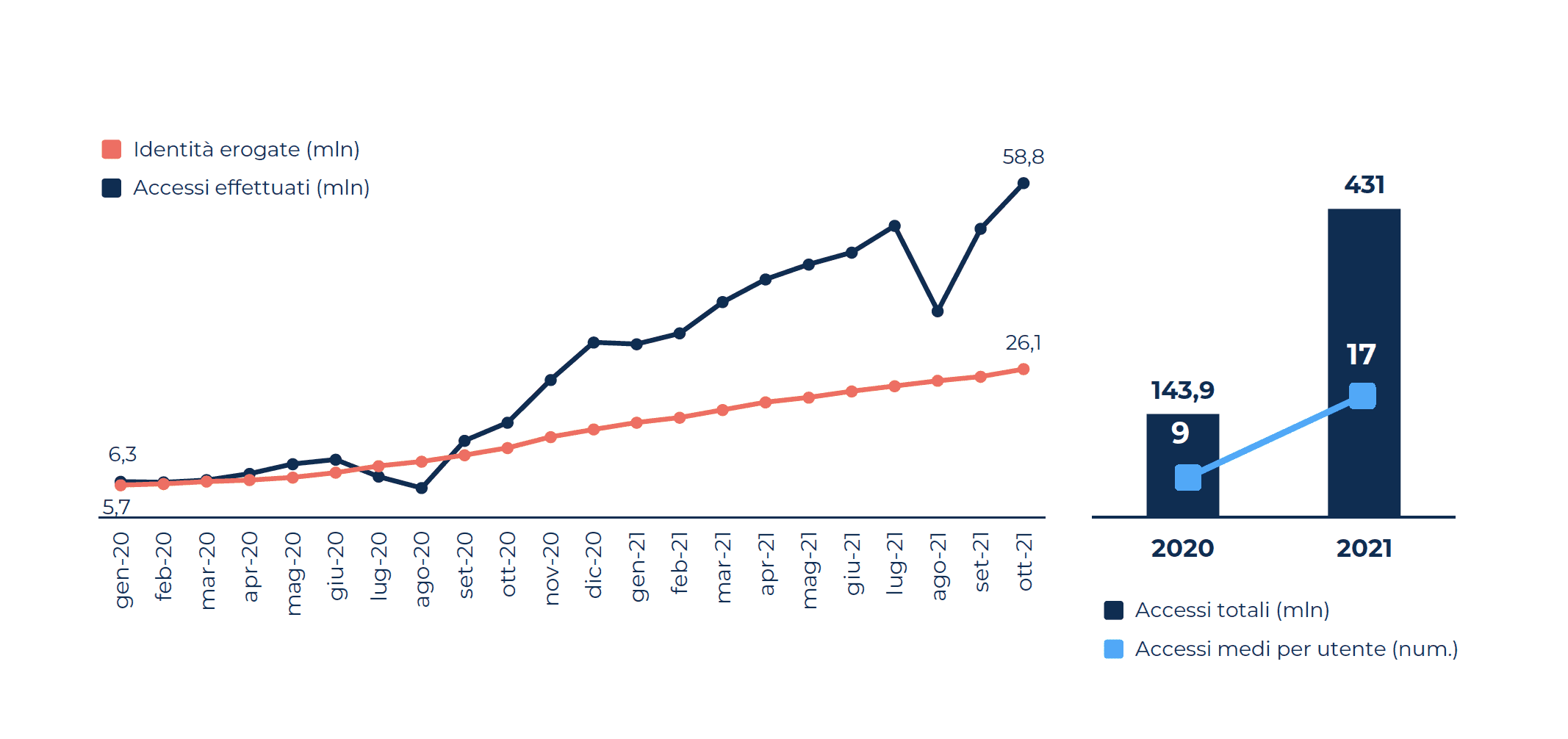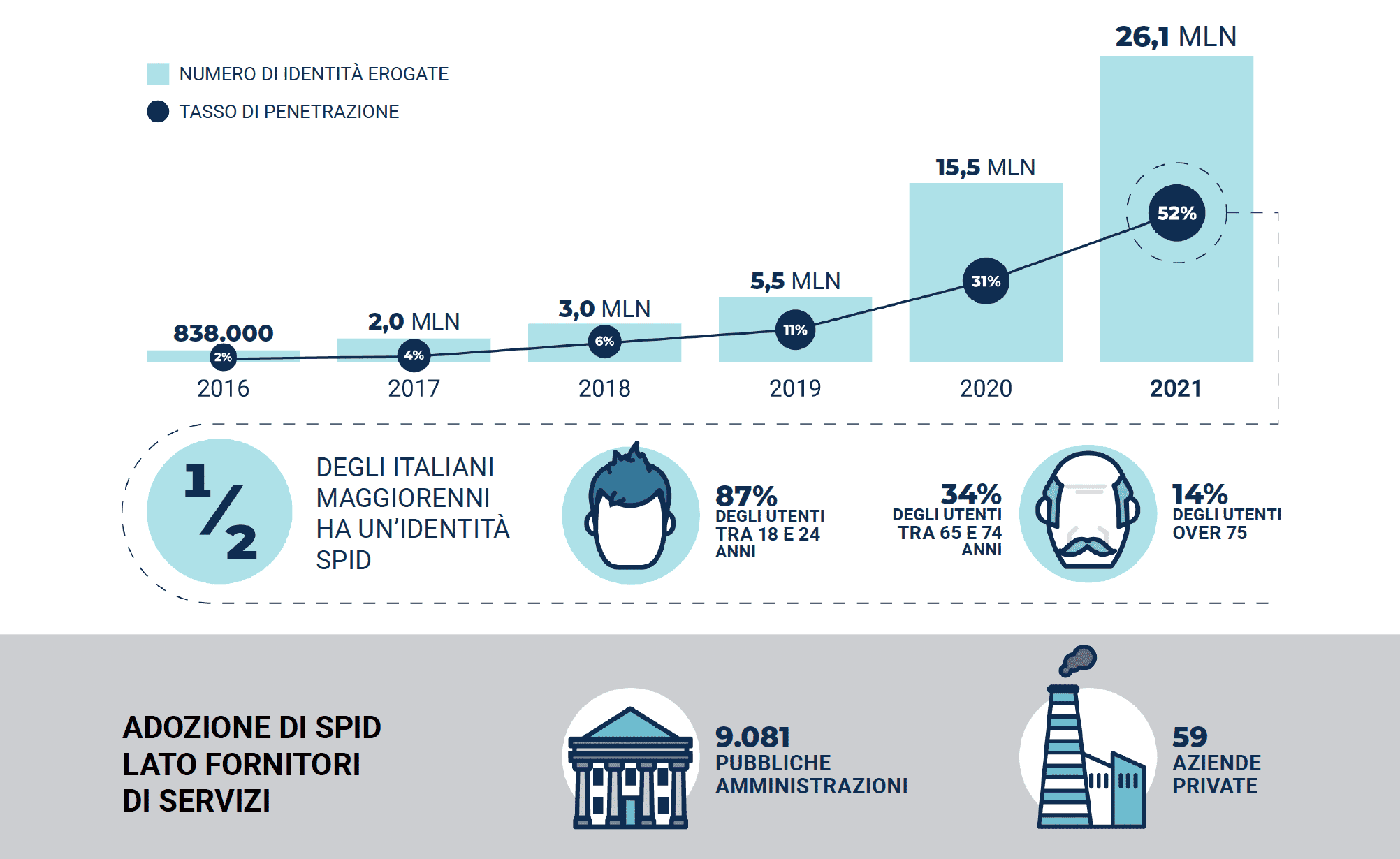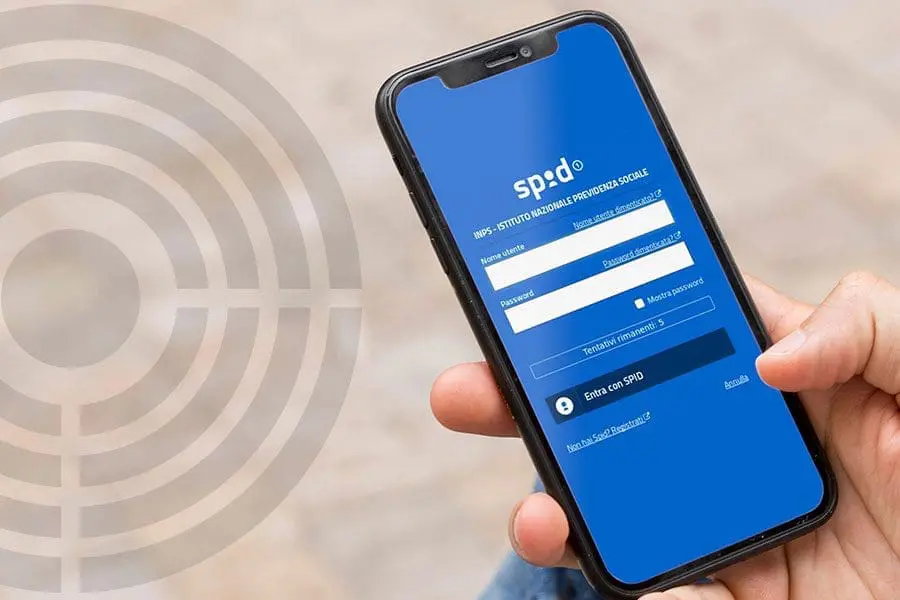(MILAN / SENIGALLIA) – December 2, 2021 – In 2021 Italy made huge progress in adoption of digital identity according to research just published by Digital Identity Observatory at the School of Management of Milan Polytechnic University. Detailed research results based on in-depth empirical research and analyses were presented in a conference November 19, 2021 and are highlighted in this article.
Namirial is supporting the work of the interdisciplinary think tank of professors, researchers and analysts in which key matters of digital innovation are being addressed. The independent research project on Digital Identity was set up to broaden the understanding of the potential of digital identity and authentication systems. Namirial experts are contributing their expertise into this research project since its inception in early 2020.Namirial Managing Director International Markets Antonio Taurisano is sharing his global experience in digital identity thanks to Namirial’s engagement in digital trust services on pan-European level and beyond.
By October 2021 43% of Italian citizens were in possession of a digital identity, up from 22% in October 2020. The Italian adoption rate is in a similar range with France (45%) and Belgium (46%) and far ahead of adoption rates in German-speaking countries. The highest adoption rate for digital identity among citizens in Europe was recorded in The Netherlands (95%), Sweden (83%) and Norway (79%).
Italy’s success in digital identity adoption is primarily based on its Public Digital Identity System (Sistema Pubblico di Identità Digitale, SPID). This national system is enabling Italian citizens, persons with permanent residence permit and Italian businesses to access public administration services online.
- Italian citizens 18 years and older as well as foreigners holding a permanent residence permit and residing in Italy can apply for a digital identity in this scheme.
- Since September 2018 SPID is a system for electronic identities notified to the European Commision under EU Regulation 910/2014 on electronic identification and trust services (eIDAS).
- Namirial is one out of nine digital identity providers within this system, audited according to ETSI Technical Standard EN 391 401 by Bureau Veritas.
The following statistics have been presented by Digital Identity Observatory at a conference in Milan Polytechnic University November 19, 2021:
Usage of Italian Public Digital Identity System
The Public Digital Identity System SPID is by far the fastest growing scheme for digital identities in Italy with more users than the system for electronic identification based on Italy’s national ID card (Carta d’Identità elettronica, CIE).
- In 2021 the amount of digital identities issued in SPID more than doubled, reaching a total of 26.1 million active users at the end of October (compared to 12.2 million in October 2020), with over 431 million accesses between January and October 2021 (triple compared accesses recorded in 2020).
- Along with the number of digital identities activated, the actual use of SPID increased 10% month on month in the first two quarters of 2021 and another 5% month on month in the third quarter. October 2021 was a record month with 58.8 million accesses in this single month.
- Between January and October 2021, each user was using his digital identity under SPID 17 times, against the average 9 accesses per user in 2020. Given the ongoing increase in use cases and their usage. An average use of digital identities under SPID in 2021 twice a month by each user is likely to be achieved.

Copyright 2021 © Politecnico di Milano Department of Management Engineering
Use Cases of Italian Public Digital Identity System
In 2021, digital identities of the Public Digital Identity System were mainly used to obtain benefits on federal and state level for which identity verification is mandatory. These include, for example, applying for child benefit, family allowance, allowances for training and studies, benefits in the area of housing subsidies or enrolments for school and refectory.
In most cases, a declaration of economic situation is required in addition to the actual application in order to apply for social and health care benefits or tariff concessions. The so-called “Uniform Income and Wealth Declaration” can be submitted online using digital identity.
- The most used services until October 2021 were those offered by the National Institute for Social Security (Istituto Nazionale della Previdenza Sociale, INPS) is the main entity of the Italian public retirement system with 19 million accesses registered.
- 13 million accesses were registered via IO app, an app designed in user-centric mode to offer easy and fast access to digital services of public administration from anywhere at any time on their mobile devices. Despite still being in beta stage the app recorded a stunning amount of more than 23 million downloads so far and might be superseding access via National Institute for Social Security in 2022.
- Seven million access were recorded for services of the Revenue Agency, four million for services of Lombardy Region and three million for services of the Ministry of Economy and Finance.
User Structure of Italian Public Digital Identity System
Roughly one out of two adults own a digital identity in SPID, 52% of Italians, with different circulation percentages depending on the age group and area of residence.
- Over 87% of young people between 18 and 24 years old are SPID users, given that it drops dramatically as the age range of the population increases, reaching 34% of 65 to 74 year olds and just 14% of over 75s.
- The highest percentage of users compared to the population are recorded in the North West with 55%, followed by the Center with 54%, by the South and Islands with 45% and by the North East with 44%.
- The most virtuous regions are Lombardy and Lazio, where 60% of citizens are registered, while in Molise, Sardinia and Calabria it is barely possible to reach 41% of users.
- Women represent 51% of the total users of the system.
The Public Digital Identity System is not only used by citizens, but also by public or private service providers with excellent growth opportunities that could materialize in 2022.
- The number of public administrations offering at least one service online through SPID increased from 4,200 to over 9,000 (+ 116%) from April 2020 to today. 6,000 public administrations (around 28% of all public administrations in Italy) are not yet part of the system. There is still a lot of catching up to do in order to offer citizens trustworthy digital services nationwide.
- The private sector is experiencing a remarkable growth rate, albeit still at a very low level: from only seven private companies that had joined SPID by November 2020, the number increased to 59 in November 2021 (+ 742.9%). Potentially, almost 175,000 companies are interested in joining SPID, which shows the excellent growth opportunities that could arise in the near future.

Copyright 2021 © Politecnico di Milano Department of Management Engineering
Challenges to intensify the use of digital identities
In 2022 and beyond, the main challenges to make the use of digital identities in Italy ideally a daily use application are the following ines:
- Driving evolution of digital identity scheme as an essential part National Recovery and Resilience Plan (Piano Nazionale di Ripresa e Resilienza, PNNR) and intelligent allocation of corresponding funding of process digitization efforts
- Increase frequency of using digital identities Enable value-added public services, thus making SPID a tool for daily use through the expansion of accessible services
- Encourage more private sector companies to adopt SPID
- Enhancing user-centric design thinking including stronger involvement of individuals
Namirial best practices in driving adoption of digital identity
Namirial is accredited by Agency for Digital Italy (AgID) as one of nine identity providers for this electronic identity system, issuing and managing “Namirial IDs” – digital identities of natural and legal persons. Digital identities are being issued and corresponding credentials provided after successful verification of personal data.
Identification for electronic identity provisioning may be executed remote or in physical contact
- Based on electronic certificate for electronic signature – download and sign an application and upload it
- Based on electronic identity on Italian National Identity Card (Carta d’Identità Elettronica, CIE) — by using an NFC enabled smartphone and the CIEiD App
- Based on electronic certificate on Italian Health Card (Tessera Sanitaria, TS) or National Service Card (Carta Nazionale dei Servizi, CNS) – by inserting card into the reader and typing in the PIN
- Based on a video identification process in real time with a Namirial identification specialist
- Face to face by specially trained identification staff in Coop shops, and by appointment at Namirial’s offices in Italy and at Namirial’s headquarters in Senigallia.
Namirial is also supporting Professional SPID, a particular type of Italy’s Public Digital Identity System enabling legal professionals and companies to access the services of the public administration and private entities.
? Detailed information on Namirial SPID offerings (in Italian language)
Within 2021 Namirial started together with some of its customers initiatives to propel the adoption of digital identities:
Free issuance of digital identity for Fineco customers
Since July 2021 more than one million FinecoBank account holders are enabled to apply for a free Namirial ID under the SPID scheme on the Fineco website.Fineco is an Italian bank that specializes in online brokerage.
? Detailed information (in Italian language)
Free identification for digital identity in Coop Italia stores
Customers of Coop Italy, the country’s largest supermarket chain, are enabled to apply for digital identity in a free physical face-to-face identification at Coop Italia stores. The service aimed to increase the number of digital identity users among those reluctant of going through a remote onboarding process.The service introduced in summer 2021 has been proven popular with less digital savvy citizens and is an important contribution to minimize the digital divide in Italian society.
Meanwhile, Namirial is the only identity provider to offer free face-to-face identification, after Poste Italiane started charging a fee of 12 euros per identification at its post offices in November 2021.
? Detailed information (in Italian language)
Next use case for digital identity will be activated soon
The latest addition among use cases for digital identity under SPID for Italian citizens is expected to be available a few days prior to year end 2021: Italian citizens might apply for disbursement of a car inspection bonus. The so-called safe vehicle bonus is granted to owners of motor vehicles who submit their vehicle to inspection operations at authorized workshops and centers.

